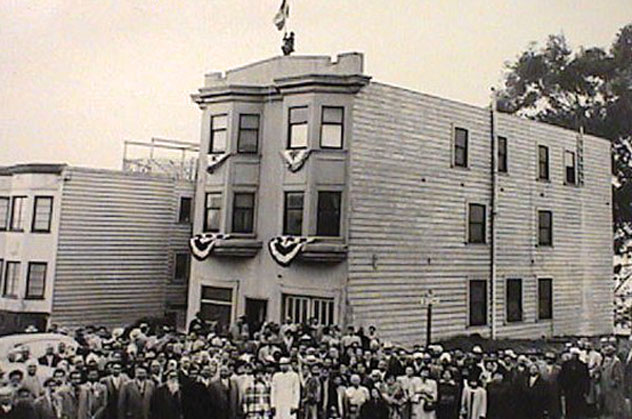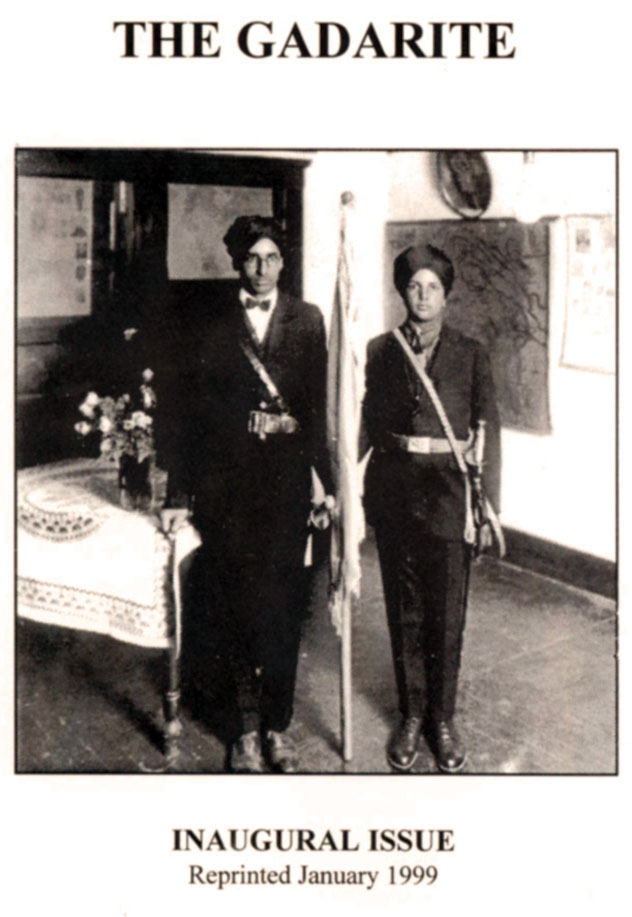OPINION:
Remembering Gadarites: A Memorial Day for Indian American
Many Indian Americans may not know the historical background of Memorial Day. However, like most Americans, they too hold parties and barbecues with family and friends. Most of the Indians in America may also not know their own day of reverence. Between 1913 and 1915, six thousand overseas Indians went back to India to fight and free their motherland from British slavery. Some paid the price with their lives, while hundreds were jailed. It is such a pity, there is no memorial day for them, writes Inder Singh.

(Above): The Gadar Party was founded in 1913 and started its operations at this building on 436 Hill Street, San Francisco. Its original home was known as “Yugantar Ashram” The photo was taken in 1951. [Photo: T.S. Sibia | UC DAVIS LIBRARY] (Below, r): Lala Har Dayal (1884 - 1939)
 In the United States, the last Monday of May is observed annually as Memorial Day – a day of national awareness and reverence, honoring those Americans who died while defending the American nation and its values. Memorial Day parades and memorial services are held to remember, reflect and honor those who have given their lives in service to their country. It was first observed on May 30, 1868 and became an official federal holiday in 1971. In the United States, the last Monday of May is observed annually as Memorial Day – a day of national awareness and reverence, honoring those Americans who died while defending the American nation and its values. Memorial Day parades and memorial services are held to remember, reflect and honor those who have given their lives in service to their country. It was first observed on May 30, 1868 and became an official federal holiday in 1971.
Indian emigrants started coming to the United States in the beginning of the twentieth century. Most of them were unskilled workers and found work in lumber mills or as farm hands. The employers preferred Indian workers as they worked hard and accepted lower wages. White laborers fearing displacement from their jobs, demanded exclusionary laws against the cheap Indian workers. The festering hostility and pent-up frustrations of American workers manifested in violence against the Indian immigrants at several places. Americans pressured their elected officials to pass exclusionary and other laws against the Asians. As a result, in 1917, Asian emigration to the United States was stopped.
At that time, higher education in the American universities was also a powerful magnet for young people. Several Indian students had joined various universities in the United States. However, upon graduation, they were unable to get jobs based on their qualifications. They attributed American employers’ discriminatory practices to their being nationals of a subjugated country.
Har Dyal, who had come from England and had been a faculty member at Stanford University for some time, was identified with nationalist activities in the United States. He inspired many students studying at the University of California at Berkeley and channelized their pro-Indian, anti-British sentiment for the independence of India. Dyal’s fervor for India’s freedom spread beyond the university campuses to Punjabi farmers and laborers who had already been victims of racial attacks, discrimination and repression from the host community.
In May 1913, at a meeting of some patriotic and enlightened Indians in Astoria, Oregon, Hindustan Association of the Pacific Coast was formed with a major objective to liberate India from British colonialism. Sohan Singh Bhakna, a lumber mill worker in Oregon, was elected president, Har Dayal, as general secretary and Kanshi Ram as treasurer. Har Dayal provided leadership for the newly formed association and was the central figure and the force behind the new organization.
The headquarters of the association was established in San Francisco and named Yugantar (new age) Ashram. Later, a building was purchased with the funds raised from the community. The association began publishing a magazine, named Gadar after the 1857 Gadar Movement (mutiny) in India. Every issue of Gadar exposed the British imperialism and called upon the Indian people to unite and rise up against the British rule. It carried articles on the condition of the people of India under British Rule and also on problems of racial attacks and discrimination against Indians in the U.S. and Canada. The publication Gadar, over a period of time, became well known among Indians and the Hindustan Association of the Pacific Coast itself became known as the Gadar party.
Gadar literature was sent to Indian revolutionaries in India, Europe, Canada and several other countries. The magazine, being the principal patriotic literature, reached many people; even if one copy reached a fellow revolutionary anywhere, multiple copies were made for circulation. The British government used every means to stop the circulation of Gadar and other such publications, particularly in India.
In August 1914, about a year after the formation of the Hindustan Association, World War I broke out in which Germany fought against England. The German government and the Gadarites had the British as common enemy. So, Germany offered the Gadarites financial aid to buy arms and ammunitions to expel the British from India while the British Indian troops were busy fighting war at the front. The Gadarites started a vigorous campaign to exhort the overseas Indians to join the freedom movement and encouraged them to go to India to launch a revolution. They drew plans to infiltrate the Indian army and excite the soldiers to fight against the British Empire and free India from the shackles of British imperialism. With funding from the German government, several ships were chartered to carry arms and ammunition to India. About six thousand overseas Indians hurried homeward to liberate their motherland.

(Above): Front Cover of ‘The Gadarite’ magazine (1951): Bud Dillon and Daswanda Singh at the Gadar Ashram before leaving for India as part of the ‘Jarha.’
Unfortunately, the traitors of the movement leaked out the secret plan to the British spies. The ships carrying arms and ammunition never reached India. Many Gadarites and revolutionaries were taken captive upon reaching India. Forty-six Gadarites were hanged to death, over two hundred were imprisoned, sixty-nine for life. In the United States too, several Gadarites and their German supporters, were prosecuted in the San Francisco Hindu German Conspiracy Trial (1917-18). Twenty-nine “Hindus” and Germans were convicted for varying terms of imprisonment for violating the American Neutrality Laws.
The Gadarites, who had a flame of liberty lit in their hearts, made sacrifices for the cause of freedom and liberty of their motherland. Although the movement did not achieve its stated objective, but it awakened the sleeping India and had a major impact on India’s struggle for freedom. The heroism, courage and sacrifices of the Gadarites inspired many freedom fighters who eventually saw India freed in 1947 from the British imperialism.
The Yugantar Ashram building was handed over to the Indian Consulate in San Francisco in 1949 and is now appropriately called Gadar Memorial Hall. It is the living symbol of the glorious sacrifices of martyrs of the freedom movement.
The Indian American community, at least on Memorial Day, should remember the sacrifices of Gadarites and pay tribute to them. The 100th anniversary of Gadar Movement is next year. All Indian Americans should seriously consider commemorating the centennial and pay the well-deserved tribute to Gadarites and Gadar martyrs.
|